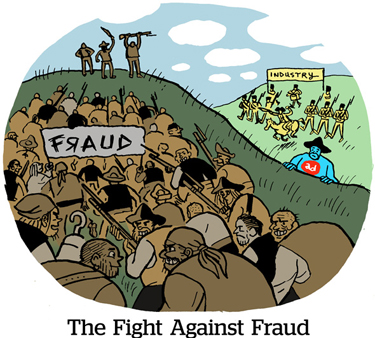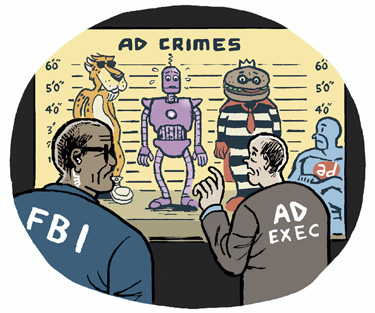Uber is suing five ad networks for squandering tens of millions of dollars on low-quality or fraudulent ads – and it’s naming names.
The suit, filed in early June in a San Francisco court, calls out Hydrane SAS, BidMotion, Taptica, YouAppi and AdAction Interactive for purchasing “nonexistent, nonviewable or fraudulent advertising.”
Users who did see the ads experienced pop-ups and auto-redirects as the networks gunned to get credit for app installs.
Uber first sued its agency, Dentsu’s Fetch, in 2017 for allegedly buying fake clicks and taking credit for installs it didn’t deserve. (Uber voluntarily withdrew its complaint in late 2018, and Fetch countersued last year for unpaid invoices, making Uber and Fetch into poster children for toxic partner relations.) This new lawsuit goes after the ad networks where Fetch placed Uber’s media budgets during the same time period.
What’s most noteworthy about Uber’s new lawsuit, other than calling out specific ad networks, is who isn’t named – roughly 100 unknown companies (“100 DOES”) which are presumably the fraudy third-party sub-publishers that the accused ad networks partnered with to generate traffic.
These John Does are “presently unknown to Uber,” according to the suit, “and Uber will seek leave of court to amend this complaint to allege such names and capacities as soon as they are ascertained.”
Hate to be cynical, but good luck with that.
“Uber failed to get blood out of that turnip [Fetch], so they are going after the next concentric circle of (smaller) companies that can’t defend themselves,” said independent fraud researcher Augustine Fou. “But even this will be futile, ultimately, since those ‘100 DOES’ are literally unknown entities, so they will never get their money back.”
So, why is Uber even trying?
Other than Uber’s aborted attempt to hold Fetch accountable, this appears to be the first high-profile example of a brand suing its ad tech partners over ad fraud. Perhaps others will follow suit with suits of their own now that the seal is broken.
“What is key here is simply the legal precedent set by a big marketer and the details of what they say [in the suit],” said Fou.
Details that amount to the anatomy of a crime that is far from unique to Uber and to the defendants in this case. Ad fraud is a story of misaligned incentives born from the murkiness of a supply chain populated by anonymous DOES mainly motivated by money – but also by the fact that most advertisers still demand volume for their campaigns while neglecting to dig into where it comes from.
So, what (allegedly) happened?
Uber’s complaint is a classic tale of ad fraud woe.
The suit alleges that the five named ad tech companies were collectively paid $70 million between 2015 and 2017 via Fetch for performance campaigns to encourage installs of the Uber app.
 But, according to the complaint, the inventory they bought was supposedly a bunch of junk. Some of the ads ran on sites Uber had explicitly blacklisted. The companies engaged in numerous fraudulent practices, such as click spoofing, spamming and ad stacking, and then they purposely falsified their reports to cover it all up.
But, according to the complaint, the inventory they bought was supposedly a bunch of junk. Some of the ads ran on sites Uber had explicitly blacklisted. The companies engaged in numerous fraudulent practices, such as click spoofing, spamming and ad stacking, and then they purposely falsified their reports to cover it all up.
BidMotion/Hydrane, for example, reported to Uber in early 2017 that they purchased the majority of their ads from ad exchanges, like Twitter-owned MoPub. So, Uber asked MoPub whether the two defendants had actually bought any inventory from its exchange. MoPub said it was “unaware of any such purchases.”
Between Q1 2016 and Q1 2017, the number of daily reported clicks on Uber ads purportedly placed by YouAppi on apps listed in YouAppi’s own reporting actually exceeded the number of daily active users (DAU) of those apps, like a flashlight app with 55,430 daily clicks … and 54,735 DAUs.
In another example, YouAppi, Taptica and AdAction failed to pass device IDs to TUNE, Uber’s mobile attribution partner, for the majority of their alleged in-app clicks.
In the same vein, although BidMotion/Hydrane claimed to only place ads on mobile apps, device ID info was almost never passed to TUNE for Uber ad placements. Nearly every attribution used a probabilistic fingerprinting method, which, the suit asserts, “is far more susceptible to fraud than the deterministic method with device IDs.”
And so on.
Uber claims that it was “diligent” in overseeing the defendants’ work, even devoting an internal team to oversee and monitor their activities.
When Uber finally suspended its paid performance campaign in March 2017, it saw no substantial drop in the total number of app installs. Rather, the number of organic installs increased by almost the exact number by which installs attributable to mobile advertising dropped – a telltale sign that paid partners were using the last click attribution method to take credit for installs they didn’t deserve.
Who’s to blame?
When advertisers realize they’ve been taken for a ride by a shady ad network, the typical course of action is to simply stop working with that network, demand a refund, dust themselves off and hopefully learn from the encounter. For its part, the ad network usually just moves on to a new, perhaps less savvy, advertiser.
What’s unique about this case is that Uber is taking its grievance public and identifying actual companies, which, Fou said, is “about damned time.”
But responsibility for the prevalence of fraud doesn’t just fall at the feet of opportunistic and/or rapacious bad actors.
“Everyone is to blame, including the advertiser who pushed for more volume and more installs,” Fou said. “The only way to get those desired volumes is through fraud – there aren’t enough humans.”
 Then again, the buck has to stop somewhere (and ideally before an advertiser is forced to demand a clawback). And ad networks that knowingly peddle worthless traffic are the worst offenders in the advertising chain after actual botnet creators, said Eric Seufert, editor of Mobile Dev Memo.
Then again, the buck has to stop somewhere (and ideally before an advertiser is forced to demand a clawback). And ad networks that knowingly peddle worthless traffic are the worst offenders in the advertising chain after actual botnet creators, said Eric Seufert, editor of Mobile Dev Memo.
These networks often clean up only after buyers start complaining, he said, another sign they know what they’re doing.
“It’s interesting that these networks are very quickly able to turn around the quality of the traffic they send you once you complain about fraud,” Seufert said.
Agencies, he said, are often the ones most likely to become addicted to the crack cocaine of high-volume, low-cost installs to keep their clients hooked. Companies right after they’ve raised a lot of money and need to start growing quickly are also easy marks. Together, agencies and startups with more sense than money can form a continuum of willful ignorance.
“The company doesn’t have any internal marketing expertise, so they outsource everything to an agency and then can’t evaluate the agency’s work,” Seufert said.
What happens next?
But performance marketers wary of mobile app networks still have to spend their advertising budgets – that’s what they do – so where are they going to turn for inventory? Facebook and Google, of course.
“Google and Facebook are the primary beneficiaries of this fraud hysteria, which makes it all the more odd that attribution providers are the ones trying to whip everyone into a frenzy over fraud,” Seufert said. “The more mobile marketing dollars that get diverted to Google and Facebook, the less necessary third-party attribution is – [and] if I was an attribution provider looking to add an ancillary revenue stream to my business, I wouldn’t be trying to convince marketers that all channels except the ones that self-attribute are replete with toxic fraud.”
But there is an alternative to taking shelter within the walled gardens: Just be prudent and reasonable in equal measure.
“There are some legitimate publishers out there with real human audiences just like there are legit mobile apps that humans actually use – advertise on those,” Fou said. “Just know that the quantities will be one one-hundredth of what they are today … the implication being that 99% of what we have today is fraud/fake.”
Uber declined to comment for this story.















